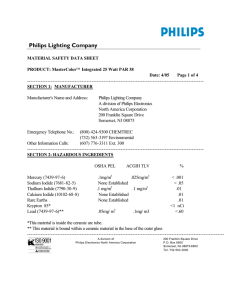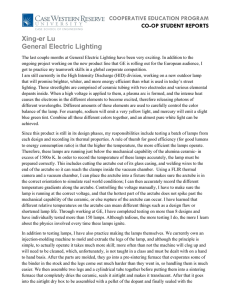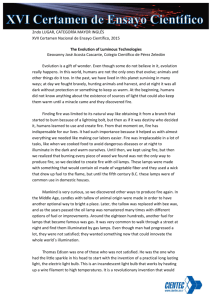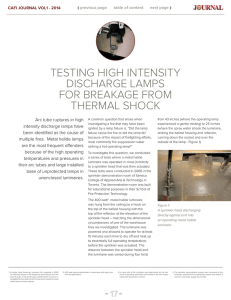Mini Master Color CDM-Tm
advertisement
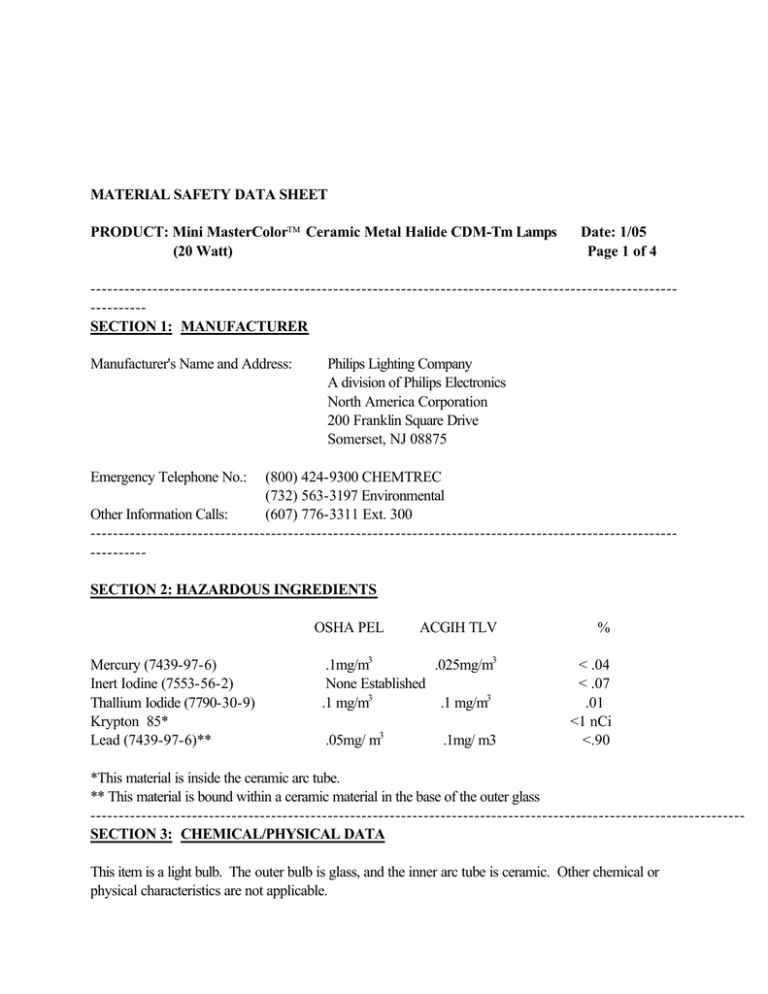
MATERIAL SAFETY DATA SHEET PRODUCT: Mini MasterColor Ceramic Metal Halide CDM-Tm Lamps (20 Watt) Date: 1/05 Page 1 of 4 ----------------------------------------------------------------------------------------------------------------SECTION 1: MANUFACTURER Manufacturer's Name and Address: Philips Lighting Company A division of Philips Electronics North America Corporation 200 Franklin Square Drive Somerset, NJ 08875 Emergency Telephone No.: (800) 424-9300 CHEMTREC (732) 563-3197 Environmental Other Information Calls: (607) 776-3311 Ext. 300 ----------------------------------------------------------------------------------------------------------------SECTION 2: HAZARDOUS INGREDIENTS OSHA PEL Mercury (7439-97-6) Inert Iodine (7553-56-2) Thallium Iodide (7790-30-9) Krypton 85* Lead (7439-97-6)** ACGIH TLV % .1mg/m3 .025mg/m3 None Established .1 mg/m3 .1 mg/m3 < .04 < .07 .01 <1 nCi <.90 .05mg/ m3 .1mg/ m3 *This material is inside the ceramic arc tube. ** This material is bound within a ceramic material in the base of the outer glass -------------------------------------------------------------------------------------------------------------------SECTION 3: CHEMICAL/PHYSICAL DATA This item is a light bulb. The outer bulb is glass, and the inner arc tube is ceramic. Other chemical or physical characteristics are not applicable. Mini MasterColor Ceramic Metal Halide CDM-Tm Lamps Page 2 of 4 SECTION 4: FIRE AND EXPLOSION DATA The outer envelope encloses a ceramic arc tube, which is refractory. There is a partial vacuum within the outer envelope. If the lamp is dropped or struck, a possible implosion could result which would cause flying glass. Warning: The arc tubes of metal halide lamps are designed to operate under high pressure and at temperatures up to 1000° C. If the arc tube ruptures for any reason, the outer bulb might break and pieces of extremely hot glass might be discharged into the surrounding environment, with the associated risk of property damage or personal injury. -------------------------------------------------------------------------------------------------------SECTION 5: REACTIVITY DATA Stability: Lamp is stable. Incompatibility: Glass Envelope will react with hydrofluoric acid. Sodium reacts with water but in this case the amount of sodium is extremely small and the reaction will not produce an open flame nor is it vigorous. Caution: If a lamp bulb support is used, be sure to insulate the support electrically so as to avoid possible decomposition to the bulb glass. Polymerization will not occur. --------------------------------------------------------------------------------------------------------------------SECTION 6: HEALTH HAZARD DATA Warning: These lamps can cause serious skin burn and eye inflammation from short wave ultraviolet radiation if the outer envelope of the lamp is broken or punctured. Do not use where people will remain for more than a few minutes unless adequate shielding or other safety precautions are used. Certain lamps that will automatically extinguish when the outer envelope is broken or punctured are commercially available. The inner envelope is composed of a ceramic material -- breakage of this envelope may result in some exposure to elemental mercury, iodine compound vapor, as well as small amounts of thallium and other iodides. You should avoid skin contact with any of the contents or fragments. Thallium is not listed as a carcinogen by NTP, IARC, or OSHA. It is a cumulative poison. It or its salts can be absorbed through intact skin; if they are ingested, they can be absorbed by the gastrointestinal tract. Mini MasterColor Ceramic Metal Halide CDM-Tm Lamps SECTION 6: Page 3 of 4 HEALTH HAZARD DATA Continued Thallium acts as a mitotic (affecting cell division) and a general cellular poison. Acute poisoning chiefly affects the central nervous system (CNS) and the GI tract. The ingestion of soluble Thallium salts causes effects rather than the pure metal. Medical conditions aggravated by the long-term exposure -disorders of the CNS, GI, kidneys, liver, and eyes. FIRST AID: Eyes: Immediately flush eyes, including under the eyelids, gently but thoroughly with plenty of running water for at least 15 minutes. Skin: Immediately wash the affected area with soap and water. Inhalation: Remove the exposed person to fresh air. Restore and/or support his/her breathing as required. Ingestion: Treat as an emergency. If the exposed person is responsive, give him or her several glasses of milk or water -- then induce vomiting. GET MEDICAL HELP FOR ALL EXPOSURES. While the amount of thallium in the arc tube is small, avoid breaking lamps. If lamps are to be broken, use adequate personal protection and ventilation. -------------------------------------------------------------------------------------------------------- SECTION 7: PRECAUTIONS FOR SAFE HANDLING AND USE Normal precautions should be taken for the collection of broken glass. Waste Disposal Method: At the end of rated life, when this lamp is removed from service, it will be subjected to the current Toxic Characteristic Leaching Procedure (TCLP) prescribed by the Environmental Protection Agency. This test is used to determining whether an item is a hazardous waste or a nonhazardous waste under current E. P. A. definition. These lamps would fail the TCLP test and would be considered hazardous under the Universal Waste Rules. Generators should evaluate all of the disposal options, which may be available in the particular state in which the generator’s facility is located. The generator should check with federal, state and local officials for their guidance. Philips encourages recycling of its products by qualified recyclers. Mini MasterColor Ceramic Metal Halide CDM-Tm Lamps SECTION 7: PRECAUTIONS FOR SAFE HANDLING AND USE Continued Safe Handling The following Good Lamp Practices 1) Only operate this lamp in approved enclosed fixtures. 2) Re-lamp fixtures at or before the end of rated life. Allowing the lamps to operate until they fail is not advised and may increase the possibility of inner arc tube rupture. 3) Before installing/replacement, shut power off and allow lamp and fixture to cool to avoid electrical shock and potential burn hazards. 4) When inserting a new lamp twist lamp 45° clock-wise in the holder to ensure proper electrical and mechanical connections. -------------------------------------------------------------------------------------------------------SECTION 8: CONTROL MEASURES Respiratory Protection: None. NIOSH-approved respirator might be used if large volumes of lamps are being broken for disposal. Ventilation: Avoid inhalation of any airborne dust. Hand and Eye Protection: Should be worn when handling broken inner arc tubes. -------------------------------------------------------------------------------------------------------SECTION 9: REGULATORY INFORMATION As a product these mercury containing lamps being shipped in the manufacturer’s original packaging are not regulated by air, truck or ocean shipment. As a waste, these spent lamps would be regulated in various states and local communities. This material safety data sheet does not constitute “knowledge of the waste”, in certain jurisdictions. Date: 1/05 S15-05001
